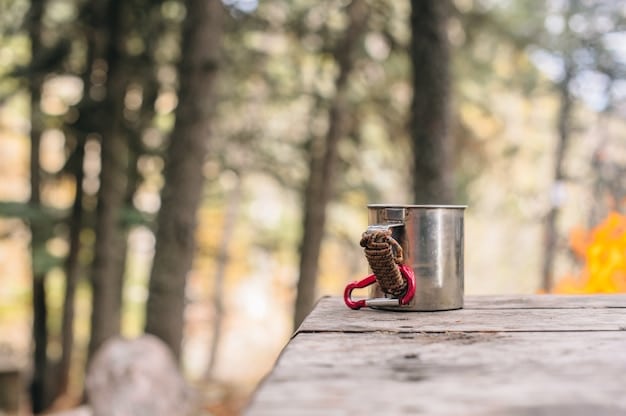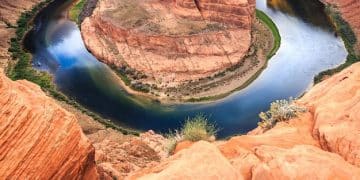Camping in US National Parks: Your Complete Guide

Camping in US National Parks requires advance reservations, knowledge of essential gear, and adherence to strict safety guidelines to ensure a memorable and secure outdoor experience.
Planning a camping trip to one of the United States’ breathtaking National Parks can be an unforgettable experience. However, a successful and safe adventure requires careful preparation. This complete guide to camping in US National Parks: reservations, gear, and safety tips covers everything you need to know to make the most of your outdoor getaway.
Choosing Your National Park Camping Destination
The US National Park system offers a diverse range of camping experiences, from the rugged mountains of Glacier National Park to the serene beaches of Acadia. Selecting the right park for your camping trip depends on your interests, experience level, and the time of year.
Consider these factors when choosing your destination:
Activities and Interests
Are you interested in hiking, fishing, rock climbing, or simply relaxing in nature? Research the activities available at each park to find one that aligns with your interests. For example, if you enjoy water sports, consider a park with lakes or rivers like Voyageurs National Park.
Experience Level
Some parks offer more challenging camping experiences than others. If you’re new to camping, start with a park that has well-established campgrounds and amenities. Zion National Park, for example, offers relatively easy access to stunning scenery and a variety of camping options.
- 🏕️ Research the best time to visit based on weather and crowd levels.
- 🗺️ Study park maps to identify campgrounds and points of interest.
- 👨👩👧👦 Consider the park’s accessibility for all members of your group.
Ultimately, the best way to choose a National Park for camping is to research thoroughly and consider your personal preferences and priorities. By taking the time to plan carefully, you can create an unforgettable camping experience that you’ll treasure for years to come.

Navigating the Reservation System
Securing a campsite in a popular National Park can be challenging, especially during peak season. Many parks require advance reservations, often months in advance, to manage the high demand. Understanding the reservation system is crucial for planning your camping trip.
The primary reservation system for National Park campgrounds is Recreation.gov. Here’s what you need to know:
Creating an Account
Before you can make a reservation, you’ll need to create an account on Recreation.gov. This is a simple process that requires your email address and personal information. Make sure to verify your email address to activate your account.
Understanding the Booking Window
Each park has its own booking window, which is the period during which you can make reservations. Booking windows can range from several months to a few days in advance. Check the Recreation.gov website for the specific booking window for the park you’re interested in.
- 📅 Mark your calendar with the reservation open date for your chosen park.
- 🌐 Create an account on Recreation.gov well in advance.
- 💻 Be prepared to book immediately when the booking window opens.
Familiarizing yourself with the specific rules and procedures for each park’s reservation system is essential. This preparation will increase your chances of securing a campsite and enjoying a seamless camping experience.
Essential Camping Gear Checklist
Having the right gear can make or break your camping trip. From shelter to cooking equipment, it’s essential to pack thoughtfully to ensure your comfort and safety. Here’s a comprehensive checklist of essential camping gear:
Consider these essential items to stay safe and comfortable:
Shelter and Sleeping
A quality tent is your primary shelter from the elements. Choose a tent that is appropriate for the size of your group and the weather conditions you expect to encounter. A comfortable sleeping bag and sleeping pad are also essential for a good night’s sleep.
Cooking and Food Storage
If you plan to cook your meals, you’ll need a portable stove, cookware, and utensils. Proper food storage is crucial for preventing encounters with wildlife. Use bear-resistant containers or hang your food from a tree to keep it safe.
Clothing and Personal Items
Pack layers of clothing to adapt to changing weather conditions. Don’t forget essentials like sunscreen, insect repellent, and a first-aid kit. A headlamp or flashlight is also essential for navigating the campground at night.
- 🔦 Pack extra batteries for all electronic devices.
- 👕 Bring moisture-wicking clothing and rain gear.
- 🎒 Organize your gear in lightweight, waterproof bags.
Proper packing is key to a successful camping trip, ensuring you have everything you need while staying organized and comfortable. Don’t underestimate the importance of packing the right gear – it can make a significant difference in your overall camping experience.

Safety Tips for Camping in National Parks
Safety should be your top priority when camping in National Parks. Wildlife encounters, weather conditions, and terrain can all pose potential risks. By following these safety tips, you can minimize these risks and enjoy a safe and memorable camping experience.
National Parks are known for unpredictable weather, rugged terrain, and diverse wildlife. Here’s how to navigate these challenges safely:
Wildlife Awareness
Learn about the wildlife that inhabits the park you’re visiting and how to respond to encounters. Store food properly to avoid attracting animals to your campsite. Never feed wildlife, as this can alter their behavior and make them dependent on humans.
Weather Preparedness
Check the weather forecast before you go and be prepared for changing conditions. Pack appropriate clothing and gear for both warm and cold weather. Be aware of the signs of hypothermia and heatstroke, and take steps to prevent them.
Navigation and Hiking Safety
If you plan to hike, carry a map and compass or GPS device, and know how to use them. Stay on marked trails and avoid hiking alone. Inform someone of your hiking plans and expected return time. Carry plenty of water and snacks.
- 🐻 Know how to react to bear and other wildlife encounters.
- 🌧️ Always check the weather forecast and be prepared for rapid changes.
- 🚶 Stay on marked trails and inform someone of your hiking plans.
Camping involves risks, but with the right knowledge and precautions, you can greatly reduce your chances of encountering problems. Safety awareness and careful planning are key to ensuring a safe and enjoyable camping trip in National Parks.
Leave No Trace Principles
Preserving the natural beauty of National Parks is everyone’s responsibility. By following the Leave No Trace principles, you can minimize your impact on the environment and help ensure that these parks remain pristine for future generations.
The Leave No Trace principles provide a framework for responsible outdoor behavior. These principles include:
Plan Ahead and Prepare
Research the park’s regulations and guidelines before your trip. Pack out all trash, including food scraps and packaging. Minimize campfire impacts by using established fire rings or portable stoves.
Travel and Camp on Durable Surfaces
Stay on marked trails and camp in designated campsites to protect vegetation and soil. Avoid creating new trails or campsites.
Dispose of Waste Properly
Pack out everything you pack in. Properly dispose of human waste by using toilets or digging a cathole at least 200 feet away from water sources.
- 👣 Minimize your impact on trails and campsites.
- 🗑️ Pack out all trash and properly dispose of waste.
- 🔥 Use established fire rings or portable stoves to minimize campfire impacts.
The Leave No Trace principles are essential guidelines for responsible camping. By adhering to these principles, we can help protect and preserve the natural beauty of National Parks for future generations. Respect for nature ensures that these precious environments remain pristine and enjoyable for every visitor.
Making the Most of Your Camping Experience
Beyond the basics of reservations, gear, and safety, there are many ways to enhance your camping experience in National Parks. Taking the time to fully immerse yourself in nature and create lasting memories is what makes camping truly special.
Enhance your camping experience through mindful planning and engagement:
Embrace Nature
Take time to observe the natural world around you. Go for a hike, watch the sunset, or simply listen to the sounds of nature. Disconnect from technology and connect with your surroundings.
Engage with fellow Campers
Camping is a great way to bond with family and friends. Play games, tell stories around the campfire, and create memories that you’ll treasure for years to come.
Capture the Memories
Take photos and videos to document your camping trip. Write in a journal to record your thoughts and experiences. These mementos will help you relive your adventure long after you return home.
- 🌄 Wake up early to watch the sunrise and enjoy the peace and quiet.
- 🧘 Take time for meditation and reflection in nature.
- 🌌 Stargaze at night and appreciate the beauty of the night sky.
Camping is more than just sleeping outdoors; it’s an opportunity to connect with nature, create lasting memories, and rejuvenate your spirit. Embrace the experience fully, and you’ll find yourself inspired and refreshed by the natural beauty of National Parks.
| Key Point | Brief Description |
|---|---|
| 📅 Reservations | Book campsites well in advance via Recreation.gov. |
| 🎒 Essential Gear | Tent, sleeping bag, cooking equipment, and appropriate clothing. |
| 🐻 Safety | Wildlife awareness, weather preparedness, and hiking safety. |
| 🌿 Leave No Trace | Minimize impact on the environment. Pack out all trash. |
Frequently Asked Questions (FAQ)
▼
It’s best to book as early as possible, often months in advance, especially for popular parks and peak seasons. Check Recreation.gov for specific booking windows for each park.
▼
Stay calm, make yourself look large, and make noise. Never run. Carry bear spray and know how to use it. Report the encounter to park authorities.
▼
Bandages, antiseptic wipes, pain relievers, blister treatment, insect repellent, sunscreen, and any personal medications.
▼
Use bear-resistant containers or hang your food from a tree at least 10 feet off the ground and 4 feet from the trunk and any branches. Never leave food unattended.
▼
Seek shelter immediately. If you’re in a tent, make sure it’s properly secured. Stay informed about weather updates and be prepared to evacuate if necessary.
Conclusion
Camping in US National Parks offers an unparalleled opportunity to connect with nature and create lasting memories. By following this comprehensive guide, you can ensure a safe, enjoyable, and responsible outdoor adventure. From securing your reservations to packing the right gear and practicing Leave No Trace principles, preparation is key to making the most of your camping experience.





